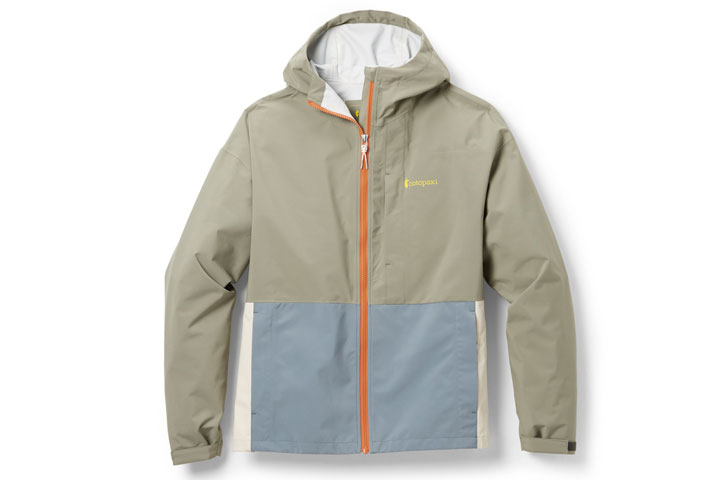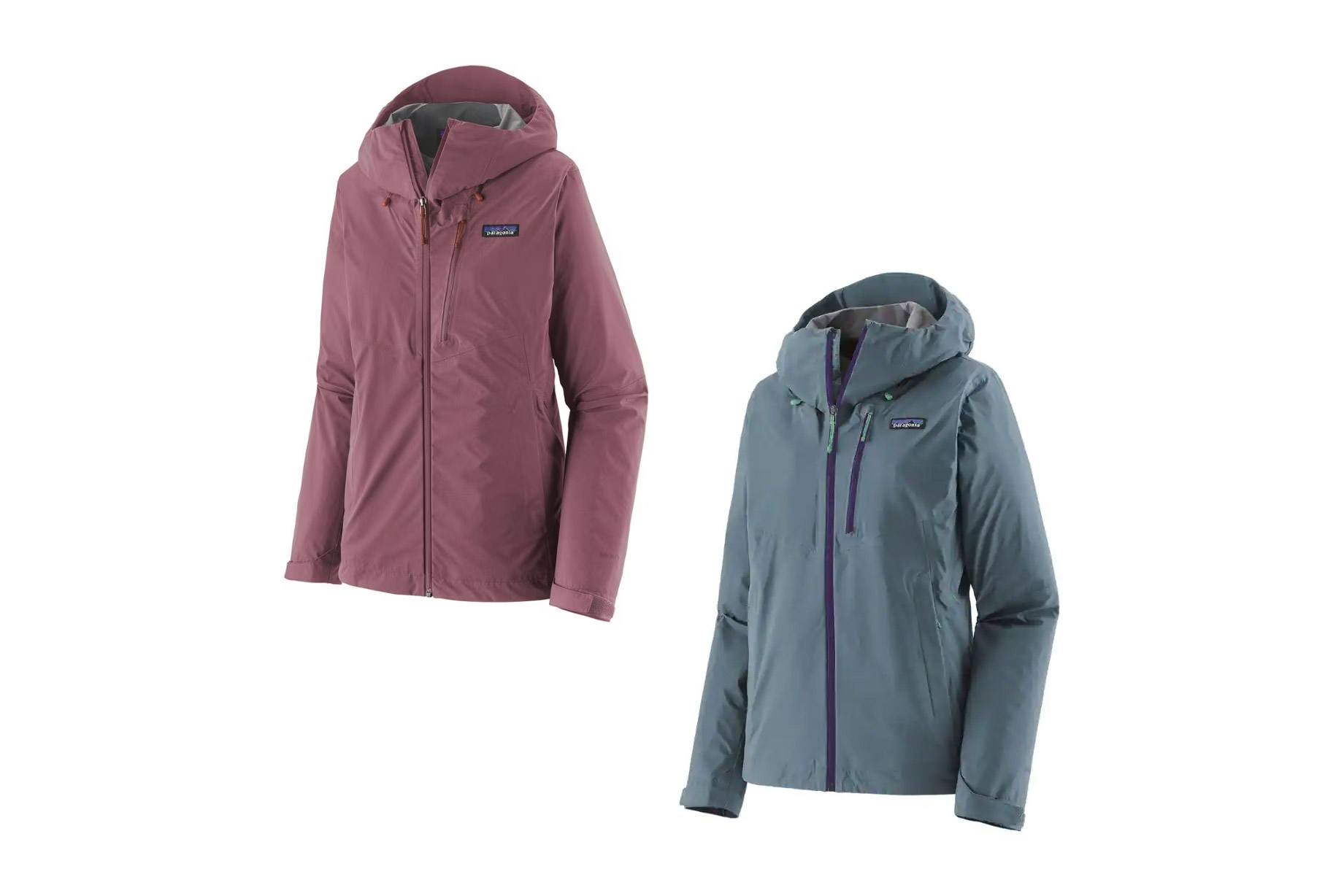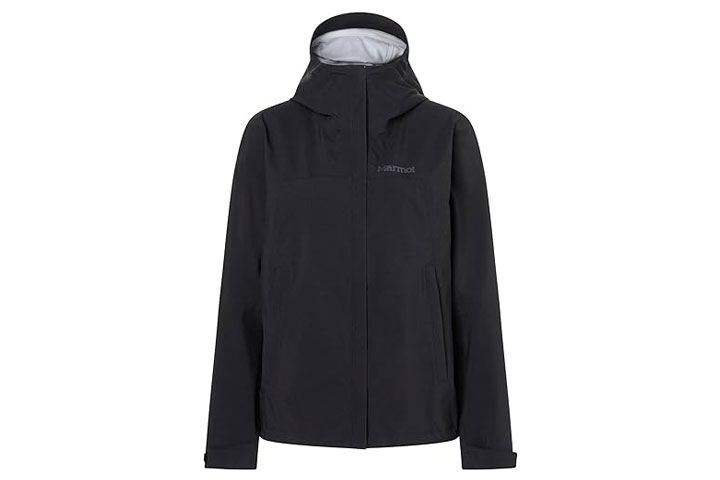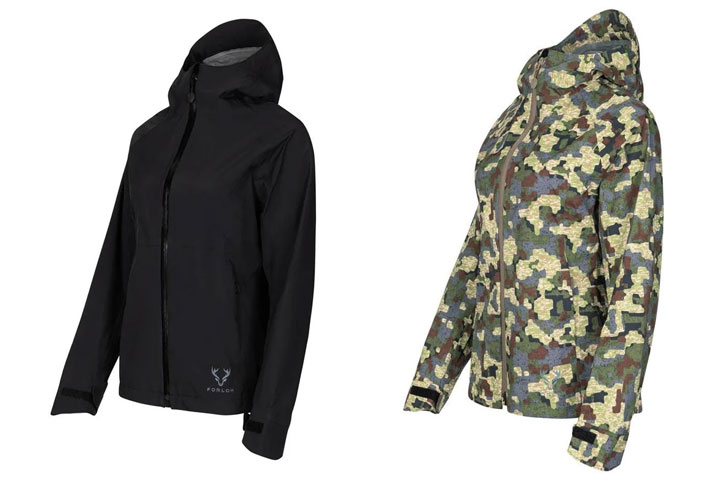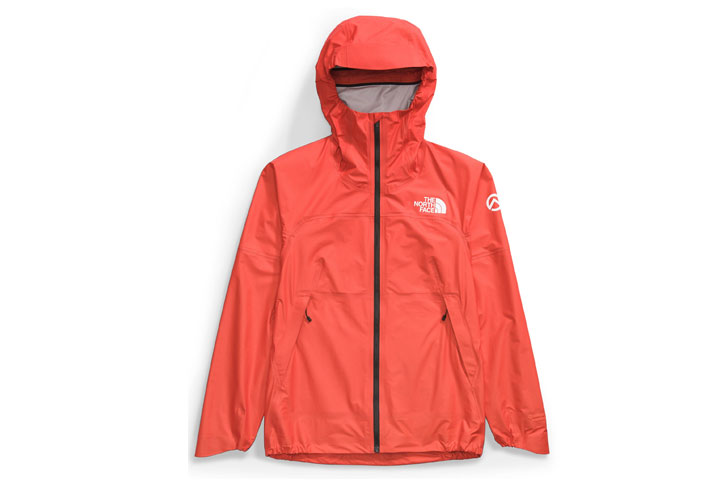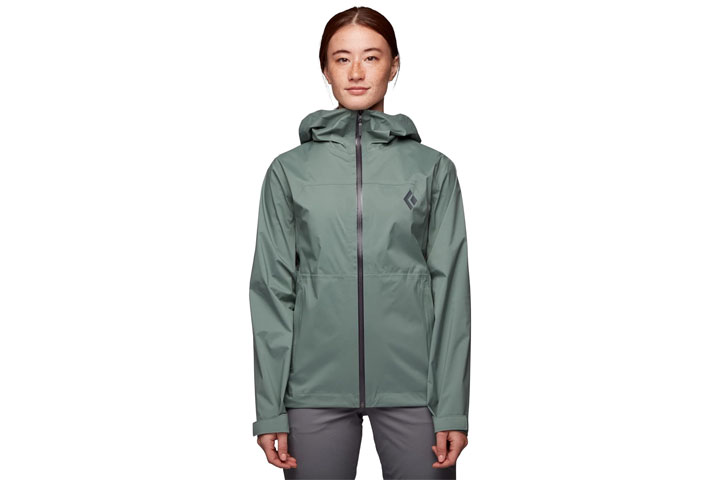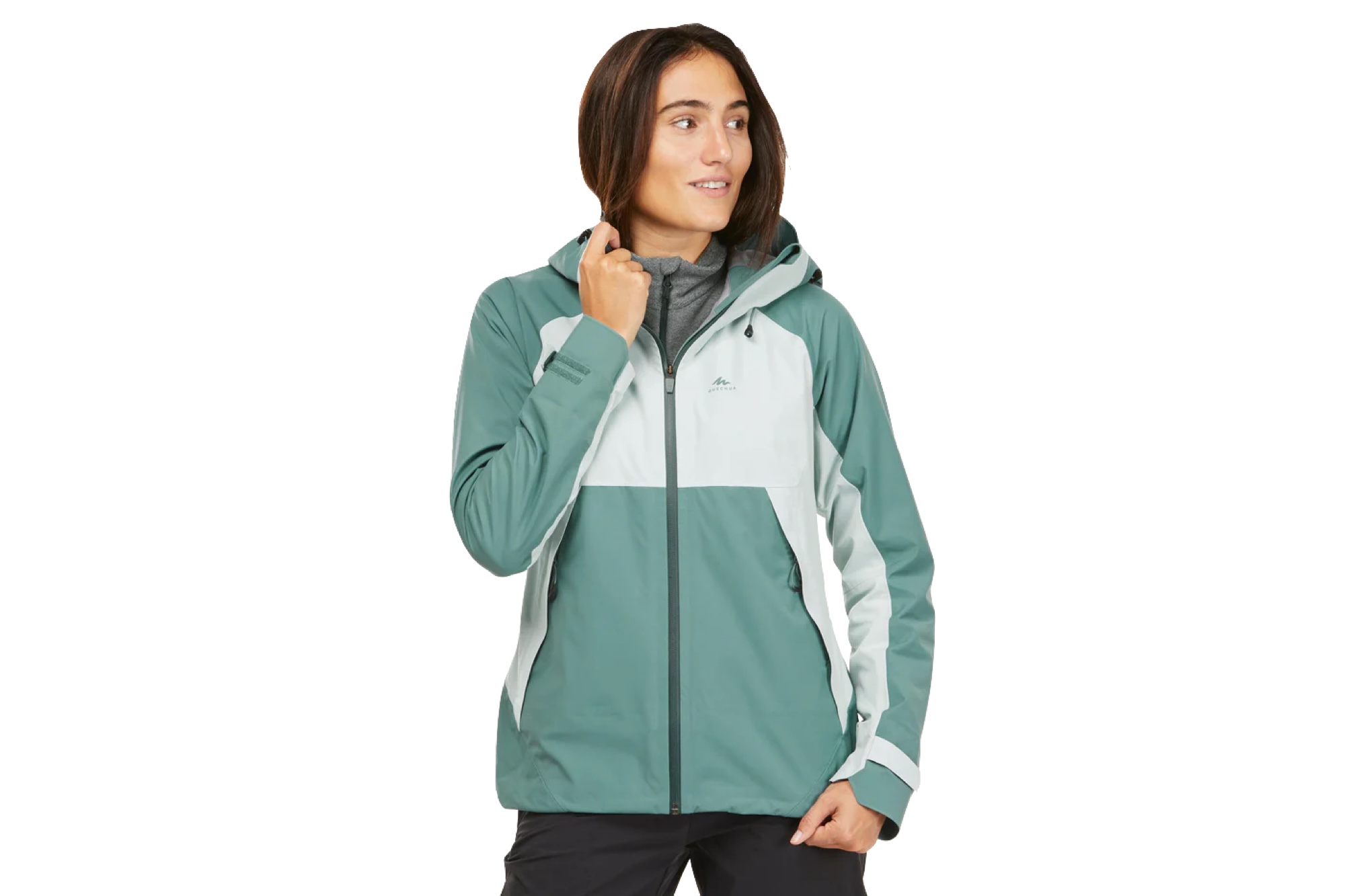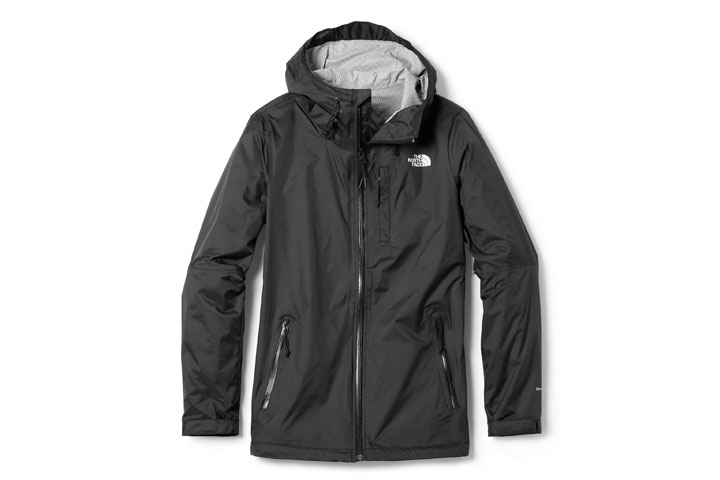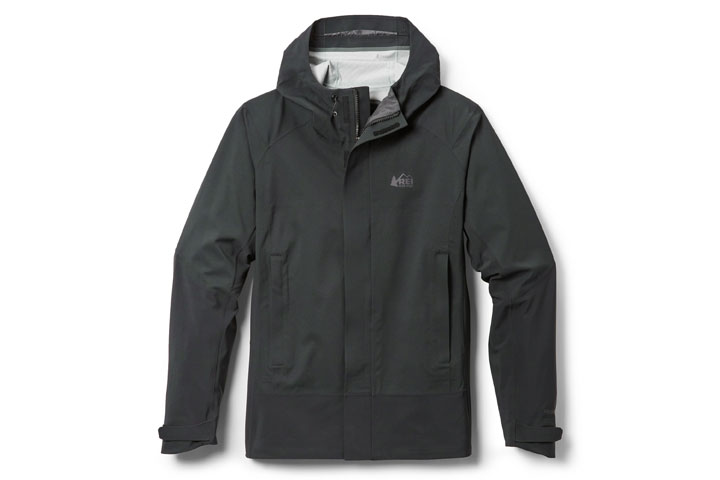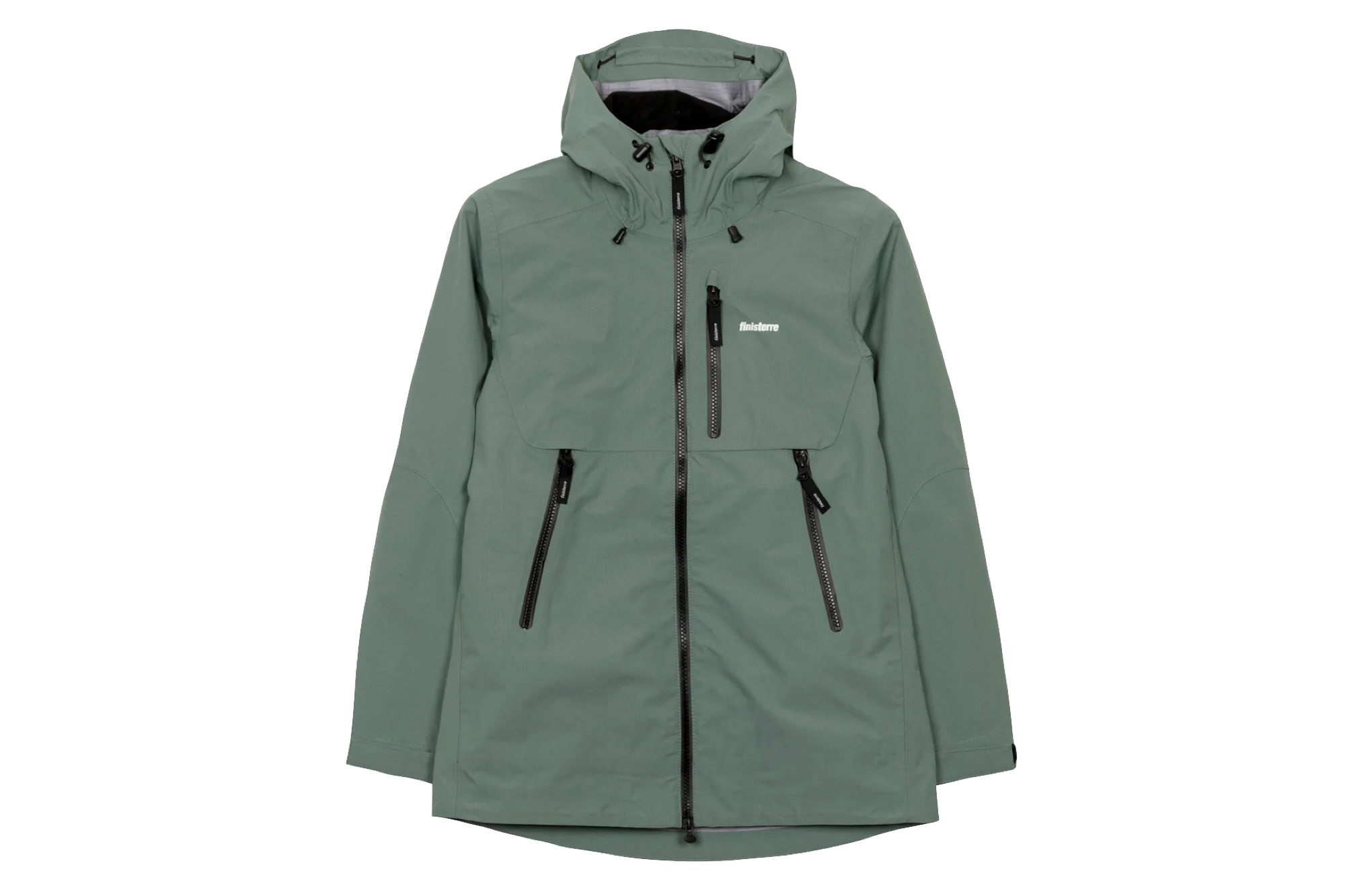The Best Women’s Rain Jackets of 2024

There is nothing quite like getting drenched in an unexpected storm, be it at a music festival, while riding your bike home, or during a far-away trek. Not only can getting soaked be uncomfortable but if it leads to chills, a drop in body temperature can lead to numbness, shivers, or even spiral into hypothermia.
Fortunately, a diverse range of top-shelf women’s rain jackets are readily available, designed to keep us dry, comfortable, healthy, and ultimately, outside! Each jacket boasts its own unique style, fit, features, materials, and general application, all of which influence its price.
With that in mind, our lead tester, Rebecca Ross — an experienced mountaineer, avid backpacker, and adventurous explorer — has leveraged her 22 years of lived experience braving the torrential rains and unpredictable squalls throughout the Pacific Northwest. She has meticulously tested every rain jacket in our line-up through both real and simulated rain showers to ensure their effectiveness. While not every shell might be the best pick for you, you’ll likely find a rain jacket in our favorites that fits the bill for your daily activities or upcoming adventures.
Scroll through to see all of our recommended buys, or jump to a specific category. At the end of our round-up of favorites, check out our Buyer’s Guide and FAQ below to help you find the best women’s rain jacket for your needs.
The Best Women’s Rain Jackets of 2024
- Best Overall Women’s Rain Jacket: Outdoor Research Aspire II GORE-TEX Rain Jacket
- Best Budget Women’s Rain Jacket: Cotopaxi Cielo Rain Jacket
- Most Versatile Women’s Rain Jacket: Patagonia Granite Crest Jacket
- Best Value Women’s Rain Jacket: Marmot Precip Eco Pro Jacket
- Best Premium Women’s Rain Jacket: FORLOH Women’s Airalite Rain Jacket
- Best Ultralight Women’s Rain Jacket: The North Face Women’s FUTURELIGHT Papsura Jacket
- Best Climbing Women’s Rain Jacket: Black Diamond Women’s Stormline Stretch Rain Shell
Outdoor Research Aspire II GORE-TEX Jacket
Specs
-
Waterproof Material
GORE-TEX Paclite 2L -
Waterproof Rating
28,000 mm/24 hours -
Breathability Rating
15,000 g/m² -
Pit Zips
Yes -
Fit
Relaxed -
Size
XS-4X -
Pockets
Three -
Weight
11.7 oz.
Pros
Hem-to-bicep side TorsoFlo zippers
The most eco-friendly OR apparel piece, with no PFCs
Very lightweight and packable
Ample coverage
Cons
Not very breathable under hard work
Pricier than some like shells
Cotopaxi Cielo Rain Jacket
Specs
-
Waterproof Material
100% recycled polyester 2.5L -
Waterproof Rating
10,000 mm/24 hours -
Breathability Rating
10,000 g/m² -
Pit Zips
No -
Fit
Boxy -
Size
XXS-4X -
Pockets
Three -
Weight
16 oz.
Pros
Budget friendly price
Stylish retro design with fun color blocking
Roomy cut for layering
C0 DWR finish and recycled polyester face fabric
Broad size range from XXS to 4X
Cons
No pit zips
On the heavier side
Hood is only single adjust
Patagonia Granite Crest Jacket
Specs
-
Waterproof Material
Patagonia H2No NetPlus 3L -
Waterproof Rating
20,000 mm/24 hours -
Breathability Rating
Unpublished -
Pit Zips
Yes -
Fit
Regular -
Size
XXS-XXL -
Pockets
Three -
Weight
12.6 oz.
Pros
Stuffs into its own pocket
Helmet compatible hood
Made from eco-conscious recycled material
Incredible all-day comfort
Good breathability
Cons
Limited bright color options
Sizing runs small
Chest pocket does not accommodate larger phones
Marmot Precip Eco Pro Jacket
Specs
-
Waterproof Material
NanoPro 3L -
Waterproof Rating
20,000 mm -
Breathability Rating
20,000 g/m² -
Pit Zips
Yes -
Fit
Regular -
Pockets
Two -
Size
XS-XL -
Weight
13 oz.
Pros
An upgrade to a 3-layer shell for not much money
Solid 20,000 g/m² breathability
Good protection for the cost
Built-in stretch doesn't limit mobility
Cons
Not very packable
Slightly heavier than regular Precip Eco shell
The North Face Women’s FUTURELIGHT Papsura Jacket
Specs
-
Waterproof Material
FUTURELIGHT 3L -
Waterproof Rating
Unpublished -
Breathability Rating
Unpublished -
Pit Zips
No -
Fit
Regular -
Size
XS – XXL -
Pockets
Two -
Weight
7 oz.
Pros
Highly breathable air-permeable membrane
Ultra-lightweight at 7 oz.
Harness and helmet compatible
Super sleek fit
Cons
Barebones feature set
Pricey to get into
Black Diamond Women’s Stormline Stretch Rain Shell
Specs
-
Waterproof Material
BD.dry 2.5L -
Waterproof Rating
10,000 mm -
Breathability Rating
10,000 g/m² -
Pit Zips
Yes -
Fit
Regular -
Size
XXS-XXL -
Pockets
Two -
Weight
9.5 oz.
Pros
Great amount of stretch
Near to skin feel
Lightweight
Climbing-helmet-compatible hood
Cons
Can produce a clammy feel when sweating
Tight around the hips
Decathlon Quechua MH500 Women’s Jacket
Specs
-
Waterproof Material
3-layer proprietary membrane -
Waterproof Rating
25,000 mm -
Breathability Rating
RET 6 -
Pit Zips
Yes -
Fit
Fitted -
Size
XS-2XL -
Pockets
Four -
Weight
15 oz.
Pros
Silent
Great hood coverage
Very comfortable
Higher than the majority of water ratings
Excellent affordability
Cons
On the heavy side at near 1 pound
Not a well represented brand in the U.S.
The North Face Women’s Alta Vista Jacket
Specs
-
Waterproof Material
DryVent 2.5L -
Waterproof Rating
Unpublished -
Breathability Rating
Unpublished -
Pit Zips
Yes -
Fit
Regular -
Size
XS-3XL -
Pockets
Five -
Weight
11.2 oz.
Pros
Five total pockets offers up plenty of storage
Affordable price
Pretty lightweight
Packable 70D fabric
Cons
Bunches in the front
Hood doesn’t stay in place
Not a very breathable jacket
REI Co-op Flash Stretch Rain Jacket
Specs
-
Waterproof Material
HydroWall 2.5L -
Waterproof Rating
Unpublished -
Breathability Rating
Unpublished -
Pit Zips
Yes -
Fit
Regular -
Size
XS-3X -
Pockets
Two -
Weight
14.5 oz.
Pros
Fantastic among of stretch
Soft collar and chin guard
Extended pit zips
Cons
New waterproof membrane is still relatively unproven
Quick water absorption on face fabric due to stretch
Finisterre Women’s Stormbird Waterproof Jacket
Specs
-
Waterproof Material
Hydrostatic polyester 3L -
Waterproof Rating
20,000 mm -
Breathability Rating
15,000 g/m² -
Pit Zips
No -
Fit
Relaxed -
Size
6-18 -
Pockets
Four -
Weight
1 lb., 7.6 oz.
Pros
Exceptional for heavy rains and strong winds
Excellent sustainability
Great value
2-way waterproof front zipper
Cons
Quite heavy
No pit zips

Women’s Rain Jacket Comparison Chart
| Women’s Rain Jacket | Price | Waterproof Material | Waterproof Rating | Breathability Rating | Weight |
|---|---|---|---|---|---|
| Outdoor Research Aspire II GORE-TEX Rain Jacket | $225 | GORE-TEX Paclite 2L | 28,000 mm/24 hours | 15,000 g/m² | 11.7 oz. |
| Cotopaxi Cielo Rain Jacket | $145 | 100% recycled polyester 2.5L | 10,000 mm/24 hours | 10,000 g/m² | 16 oz. |
| Patagonia Granite Crest Jacket | $279 | Patagonia H2No NetPlus 3L | 20,000 mm/24 hours | N/A | 12.6 oz. |
| Marmot Precip Eco Pro Jacket | $160 | NanoPro 3L | 20,000 mm | 20,000 g/m² | 13 oz. |
| FORLOH Women’s Airalite Rain Jacket | $399 | Airadigm Pulse Plasma 3L | 35,000 mm | 23,000 g/m² | 14.8 oz. |
| The North Face Women’s FUTURELIGHT Papsura Jacket | $400 | FUTURELIGHT 3L | N/A | N/A | 7 oz. |
| Black Diamond Women’s Stormline Stretch Rain Shell | $180 | BD.dry 2.5L | 10,000 mm | 10,000 g/m² | 9.5 oz. |
| Decathlon Quechua Women’s MH500 Jacket | $109 | 3-layer proprietary membrane | 25,000 mm | RET 6 | 15 oz. |
| The North Face Women’s Alta Vista Jacket | $140 | DryVent 2.5L | N/A | N/A | 11.2 oz. |
| REI Co-op Flash Stretch Rain Jacket | $169 | HydroWall 2.5L | N/A | N/A | 14.5 oz. |
| Finisterre Stormbird Waterproof Jacket | $295 | Hydrostatic polyester 3L | 20,000 mm | 15,000 g/m² | 1 lb., 7.6 oz. |
How We Tested Women’s Rain Jackets

We’re no fair-weather crew here at GearJunkie, and a little precip in the forecast is only a footnote in most of our weekend plans. A solid rain jacket is an essential part of our tool kit, but finding the perfect rain jacket can be an effort in futility without a little ground truthing.
Specs and marketing terms look good on paper, but like they say: it all comes out in the wash. Thankfully, we’ve put in the time in everything from a coastal mist to an honest mountain deluge, and we took these rain jackets along for the ride to see which made the grade.
Our lead tester, Rebecca Ross, has braved the tempestuous weather of the Pacific Northwest for over 22 years, seven of which were dedicated to scaling and backpacking alpine and sub-alpine terrain in the Cascades, where weather shifts are frequent. With four years of intensive gear testing experience, her expertise is invaluable.
In crafting this guide, we left no stone unturned. Each rain jacket underwent thorough examination, employing a range of methods including storm chasing, indoor showers, and even encounters with waterfalls. Our aim was to deliver a comprehensive review encompassing diverse environments to provide detailed insights. By now, our testers have been hands-on with just about every waterproof membrane and construction out there, and we’ve built up a pretty good knowledge base in terms of what excels.
Through our testing, we’ve run DWR finishes into the ground (and revitalized them), stood out in the rain longer than any sane person would, and even split a few seams to inspect construction techniques. We placed particular emphasis on waterproofness and breathability while meticulously scrutinizing the finer details that distinguish each rain jacket. Our commitment was to deliver a comprehensive analysis, showcasing only the cream of the crop in rain gear.
Because not every rain shower is going to be a hurricane and not every trip an expedition, we looked at a broad spread of rain jackets — from city slickers keen on getting you from the bus stop to the front door, to sport-specific shells that are tailor-made for what you’re getting up to this weekend. We also know that gear budgeting is a thing, and we tested jackets that ranged from those barely breaking a hundred, to some that demand a fistful of bills.
Pulling together testing from all of our testers, we’re confident that the jackets listed here are well worth it, and you should be confident that they have been well-vetted. As new women’s rain jackets hit the market, we’ll hit the trail and keep up our testing — and aim to keep our selection as fresh as possible.
Buyer’s Guide: How to Choose a Rain Jacket

Navigating through the multitude of rain jackets available in today’s saturated market can feel overwhelming. While having a plethora of choices is advantageous, it can also complicate the process of finding the perfect fit.
In this comprehensive buyer’s guide, we not only outline the key factors to consider when selecting the ideal rain jacket for your needs but also provide expert insights and tips to help you navigate through the array of options available.
So, whether you’re a casual hiker, a seasoned outdoor enthusiast, or someone simply looking for reliable protection against the elements, this guide aims to empower you with the knowledge necessary to make a confident and well-informed purchase decision.
Fit and Length

Rain jackets, like any outdoor attire, vary significantly in the way they feel, particularly concerning fit and length. A reliable rain jacket should effectively cover your upper half while allowing ample room for movement.
When selecting a rain jacket, consider its fit. Many jackets offer options such as Standard, Average, and Regular fits. However, there are also some out there that provide a more unique fit. For example, the Decathlon Quechua has a more tailored cut, while the Finisterre Women’s Stormbird is fairly roomy, and the Cotopaxi Cielo Rain Jacket has a boxy fit. If you anticipate wearing thicker midlayers underneath, sizing up might be necessary.
Another important factor to contemplate is the jacket’s back length. While most jackets nowadays incorporate a drop hem or a longer hem for enhanced coverage from behind, this feature isn’t universal. On our list, drop hems range from 27 inches, as seen in The North Face Women’s Alta Vista, to more ample coverage of 33 inches, like The North Face Papsura. The longer the hem, the more coverage it provides, especially while on the move.
Pockets

It’s uncommon to find a jacket without pockets, even among ultra-lightweight options. You’re likely to have space for both your hands and essentials while on the move. However, there are a few factors to consider.
If you prefer having your phone within easy reach, consider a jacket with a chest pocket, though not all jackets feature them. Additionally, features like key loops can be invaluable for ensuring your keys make it back to the car after a long hike.
Also, keep in mind that if you plan on carrying heavier items, then jackets with thicker construction can prevent them from jostling around. Jackets on our list with a good number of sturdy pockets are the Decathlon Quechua and Finisterre Stormbird Jacket, both featuring four pockets to keep items secure.
But if you prefer staying organized for all your lightweight items, The North Face Women’s Alta Vista Jacket has five pockets, including three zip pockets and two interior drop-in pockets.
Waterproof Membranes

Waterproof membranes are essential components of rain jackets, serving as thin barriers to repel moisture and water. These membranes, available in various types, cater to different outdoor activities and weather conditions.
Starting with the most renowned for its quality, GORE-TEX utilizes expanded polytetrafluoroethylene (ePTFE) to create microscopic pores that allow vapor to escape while blocking water droplets. GORE-TEX offers several options:
- GORE-TEX Pro: Designed for extreme weather and high-intensity activities, GORE-TEX Pro features a unique ePTFE membrane with microscopic pores that ensure exceptional waterproofness and breathability. It’s favored by outdoor enthusiasts and professionals for its durability and performance, and more often seen in rugged hardshell jackets for climbing or skiing.
- GORE-TEX Paclite & Paclite Plus: These membranes are widely used in hiking and backpacking rain jackets for their high waterproofing rating. Paclite jackets omit the textile backer and use a layer of polyurethane and carbon on the interior, making them highly packable. Paclite Plus enhances durability while maintaining exceptional waterproofing performance.
- GORE-TEX Active: Prioritizing breathability, GORE-TEX Active features lightweight and minimal construction that is suitable for high-intensity pursuits.
Other notable membranes include:
- eVent: Known for high breathability, eVent utilizes ePTFE membrane technology, allowing moisture vapor to escape while preventing water from entering. It maintains breathability even in wet conditions by removing the polyurethane layer that most GORE-TEX layers apply internally.
- Pertex Shield+: Achieving a balance between water resistance and breathability, Pertex Shield+ utilizes a polyurethane film membrane. However, jackets made with these membranes may occasionally experience perspiration buildup.
Moreover, rain jackets with proprietary membranes are commonly less expensive than rain jackets that feature the above name-brand membranes. Examples include Black Diamond’s BD.dry and The North Face’s FUTURELIGHT or DryVent.
Fabric Layers
The fabric layers of rain jackets are intricately designed to offer protection against the elements while ensuring breathability and comfort. Typically, rain jackets consist of two or three layers, each serving a specific function:
- 2-layer: Simplicity reigns. These waterproof fabrics utilize a waterproof membrane and an outer face fabric to shield against scuffs and scrapes. Often, an internal hanging liner will be used to create a stand-off between the skin and the jacket, which both improves airflow and wicks away moisture. The Paclite used in the Outdoor Research Aspire II jacket is an excellent example of a jacket that doesn’t use this lining, in order to save on weight and bulk.
- 2.5-layer: A thin protective lining is added to the inside of the waterproof membrane, often laminated, screen printed, or sprayed on. This design, found in jackets like Black Diamond Stormline Stretch and REI Co-op Flash Stretch, enhances longevity and breathability by minimizing body oils and dirt that can clog membrane pores. However, they may feel clammy in prolonged rain and lack the moisture-wicking properties of three-layer jackets.
- 3-layer: The pinnacle of rain jacket performance lies in 3-layer constructions, featuring a third wicking textile inside the membrane. While these jackets excel in moisture management, they typically come at a higher price point. We have a handful on our list that offer 3-layer construction, including the Patagonia Granite Crest Rain, The North Face Papsura, and the FORLOH Airalite Jacket.
In essence, rain jacket fabric layers are engineered to balance waterproofness, breathability, durability, and comfort for comprehensive all-weather protection. When choosing a rain jacket, consider its layer construction and materials to ensure they align with your performance and comfort needs.
Durable Water Repellent Finish (DWR)

A rain jacket’s primary defense lies in its durable water-repellent (DWR) finish, a hydrophobic coating that causes water to bead up and slide off the surface. This coating helps prevent water from saturating the waterproof membrane, thus extending the jacket’s waterproofing capability.
However, DWR finishes degrade over time, especially with washing, leading to reduced water repellency. To restore your rain jacket’s performance, it’s essential to reapply a DWR treatment periodically.
Indications of diminished performance include “wetting out,” where water penetrates the fabric instead of beading off. This signals that the DWR treatment is compromised, impacting the jacket’s effectiveness. Additionally, wetted-out fabric can hinder breathability, as moisture expulsion becomes inhibited.
Factors like abrasion, oils, and environmental debris contribute to DWR degradation. Therefore, maintaining cleanliness and periodically reapplying a DWR treatment is crucial for preserving your rain jacket’s performance.
Waterproofness

Waterproofness is gauged by the amount of water a fabric can withstand before leaking over a 24-hour period. The minimum standard for waterproof designation is 1,000 mm, suitable for light drizzles encountered in everyday activities like walking your dog. However, for more extreme weather conditions during outdoor adventures, opt for jackets with ratings between 5,000 mm and 30,000 mm.
Pressure, such as from backpack straps or heavy snow, can compromise the waterproofness of a rain jacket. Different waterproof ratings offer varying levels of protection:
- 5,000 mm: Begins technical rain outerwear for outdoor adventures.
- 5,000-10,000 mm: Waterproof under light rain or snow without pressure.
- 10,000-15,000 mm: Waterproof under most conditions except pressure.
- 15,000-20,000 mm: Waterproof under heavy rain and snow.
- Over 20,000 mm: Waterproof under heavy rain, snow, and pressure.
There are a handful of rain jackets featured on our list that surpass the 20,000 mm mark, providing options for staying dry even in severe conditions. Options like the Finisterre Stormbird and Marmot Precip Eco Pro Jacket offer excellent protection. However, for the utmost assurance of waterproofing, consider the FORLOH Airalite Jacket with an impressive rating of 35,000 mm.
Breathability

Breathability is essential in rain jackets to ensure comfort during outdoor activities by allowing sweat to escape while repelling water, preventing the wearer from feeling clammy or overheated.
Air-permeable membranes, such as those found in FUTURELIGHT or Airadigm jackets, are revolutionizing the outerwear industry by offering a balance between breathability and waterproofness. These membranes permit air to pass through while still repelling water, though they may sacrifice some waterproofness compared to traditional options.
One of the key metrics used to assess breathability is the moisture vapor transmission rate (MVTR), measured in grams per square meter per 24 hours (g/m²/24h). Higher MVTR ratings indicate better performance. For example, jackets designed for high-output activities typically have a breathability rating of 20,000 g/m² or more, while those intended for casual use may suffice with ratings between 10,000 and 15,000 g/m². The FORLOH Airalite jacket, with a breathability rating of 23,000 g/m²/24h, stands out as one of the most breathable options available.
An additional breathability metric is the RET (Resistance to Evaporative Heat Transfer). A jacket with a RET value below 6 is exceptionally breathable, such as the Decathlon Quechua jacket, which excels at allowing perspiration to escape.
When selecting a rain jacket, it’s crucial to consider the intended activity level to ensure the right balance of breathability and waterproofness for your needs.
Taped Seams and Zippers

Taped seams and YKK zippers are fundamental for preserving the waterproof integrity of a rain jacket. Taped seams, sealed with waterproof tape crafted from materials like polyurethane or GORE-TEX, offer top-tier waterproofing, ensuring the jacket stays dry even in heavy downpours.
Simultaneously, YKK zippers are celebrated for their durability, smooth functionality, and resistance to corrosion. Utilizing YKK zippers ensures dependable and long-lasting closures, perfect for enduring demanding outdoor environments. Keep an eye out for these features when selecting a rain jacket for peak performance and durability in wet conditions.
Weight and Packability

When considering weight and packability for your journey, it’s crucial to factor in the distance you’ll be covering and how much you’re willing to carry — every ounce counts. For minimal weight priorities, consider The North Face Papsura, weighing just 7 ounces, or the Black Diamond Stormline Stretch at 9.5 ounces.
However, if weight isn’t your primary concern and you expect your jacket to be worn most of the time, you have numerous options to explore.
For those mindful of space limitations, look for jackets that can be neatly packed into its own pocket, condensing to roughly larger than a softball for optimal packability. Some jackets even feature a loop for easy attachment to a harness or the exterior of your backpack, ensuring convenient access without taking up precious space inside your pack. This feature is especially handy during activities like rock climbing, where space is limited.
For an easier decision-making process, refer to the comparison table provided above. It offers a quick and simple overview of the weight differences among the rain jackets.
Hoods

Some rain jackets come with hoods will serve a dual purpose as a convenient storage sack. But most likely if it’s raining hard enough to necessitate wearing a rain jacket, you’ll likely also have the hood up. A well-crafted hood should offer comprehensive protection. A good example is a hood that completely covers your head and features three-point adjustments to ensure a proper fit without compromising peripheral vision.
It’s essential to ensure that your hood can accommodate any helmet you might wear. If your plans include climbing or alpine activities, consider exploring helmet-compatible options such as the Black Diamond Stormline Stretch, The North Face Papsura, and Patagonia Granite Crest.
Sustainability

A sustainable rain jacket encompasses various aspects such as eco-friendly materials, low-impact production, fluorocarbon-free waterproofing, durability, end-of-life solutions, and ethical practices. Key features to look for include Bluesign certification — ensuring fabric meets rigorous environmental and safety standards — and Fair Trade Certification, which ensures sustainable livelihoods for textile workers.
The Finisterre Stormbird Jacket emerges as the most sustainable options we tested, employing practices such as the use of recycled nylon and organic materials, fluorocarbon-free waterproofing since 2017, minimization of its carbon footprint through land and sea transport, utilization of water-soluble packaging, and provision of repair and trade-in services to prolong product life. The brand’s commitment to transparency and close partnerships with manufacturers further reinforces its sustainability efforts.
Furthermore, Outdoor Research is making strides with the Aspire II GORE-TEX Rain Jacket, touted as the most eco-friendly addition to its spring 2024 product line, thanks to its use of sustainable materials and removal of certain forever chemicals.
Durability and Longevity

Durability and longevity are paramount in rain jackets that can keep up with all your outdoor activities and daily wear. This is achieved through high-quality materials, reinforced construction, efficient waterproofing treatments including DWR (durable water repellent), and durable hardware like YKK zippers.
Following manufacturer guidelines for care and performing periodic maintenance are essential for prolonging the jacket’s lifespan. Moreover, warranties offered by reputable brands provide added assurance of long-term performance.
FAQ
Rain jackets should fit comfortably, allowing for movement and layering underneath. Ensure the length provides ample coverage, sleeves cover your wrists, and the hood fits well, and shoulder seams should align with your shoulders. We do suggest trying it on before purchasing as some jackets can run small or large.
Your rain jacket may become damp inside due to factors like condensation, reduced breathability, damage, or improper sizing. To prevent this, ensure your jacket is clean, consider applying a DWR treatment if necessary, wear moisture-wicking layers, and regularly check for damage.
Water-resistant jackets repel water to some extent but are not fully waterproof. They can withstand light rain but may not keep you dry in heavy downpours. Waterproof jackets, on the other hand, are designed to keep you dry even in heavy rain or wet conditions, offering superior protection against moisture.
When layering with a rain jacket, begin with a moisture-wicking base layer to manage sweat and keep your skin dry. This could be a lightweight, breathable top made from materials like merino wool or synthetic fabrics.
Depending on the weather and your activity level, you may add an insulating midlayer for warmth like a fleece, down, or synthetic insulating midlayer. And depending on conditions you may opt for additional accessories like gloves and beanie for added warmth.
No, waterproof jackets do not stay waterproof forever. Over time, the waterproofing capabilities of a jacket can diminish due to various factors such as wear and tear, exposure to environmental elements, and the breakdown of waterproofing treatments like DWR (Durable Water Repellent) coatings.
Continuous use, abrasion, washing, and exposure to dirt, oils, and UV radiation can all contribute to the deterioration of a jacket’s waterproofing properties. Therefore, it’s essential to maintain and care for your waterproof jacket by periodically reapplying waterproofing treatments, cleaning it according to the manufacturer’s instructions, and inspecting it for signs of wear or damage.
Wetting out occurs when the outer fabric of a rain jacket becomes saturated with water, compromising the effectiveness of the waterproof membrane. This can result from the degradation of the DWR (durable water repellent) finish or external pressure, such as a heavy backpack, forcing moisture into the fabric. Additionally, an insufficient waterproofing rating can contribute to water seepage, particularly if a jacket intended for light rain encounters prolonged heavy precipitation.
To mitigate wetting out, it is advisable to choose a rain jacket with a high waterproof rating. Regularly washing and reapplying waterproofing treatments can also help maintain its effectiveness.
The Best Rain Jackets of 2024
Whether you’re splashing about town or trekking through a monsoon, these are the best rain jackets of 2024.
The Best Hardshell Jackets of 2024
Whether you’re getting good sticks in hero ice or traversing the snowfields of some foreign range, a good hardshell jacket will have your back. After…
The post The Best Women’s Rain Jackets of 2024 appeared first on GearJunkie.


